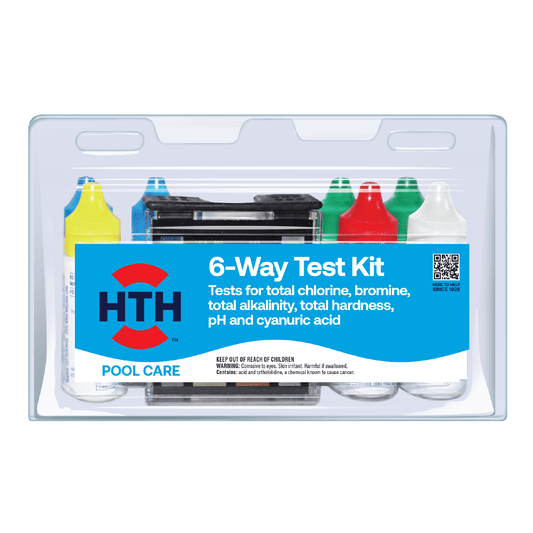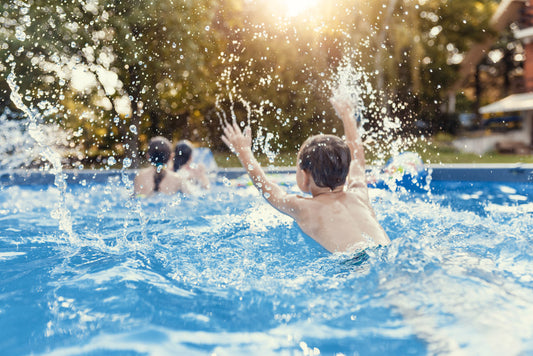How much shock do I add to my swimming pool?
SKIMMER NOTES: Calculate your total pool volume first, then check the package of shock for dosing recommendations by volume. Typically for granular shock, you'll need one pound for every 10,000 to 13,500 gallons of pool water.

Need more help?
Call us
Prefer to call us?
We've got someone standing by daily from 9 a.m. – 7 p.m. ET, Monday – Friday
(866)-HTH-POOL- Category:
- Pool •
- Pool Maintenance •
With over 8 million residential swimming pools across the US ranging from 5 thousand gallons to over 30 thousand gallons, the amount of shock you need to treat a swimming pool isn’t a one-size-fits-all answer. But it IS an easy answer to get to. To figure out how much shock you need to put in your swimming pool, all you need to know is the total volume of your swimming pool in gallons.
How to calculate the total volume of your swimming pool:
1) Call the pool company that built your pool. They should have your dimensions and volume on hand.
2) Use a pool volume calculator online. You'll need the dimensions of your pool for accuracy.
3) Calculate your pool volume yourself. (We'll walk you through it).
The pool volume equation for a rectangular pool is:
Length x Width x Average Depth x 7.5
Start by calculating your average depth: that’s your shallow-end depth plus your deep-end depth divided by two.
(Shallow end + Deep end) / 2 = Average Depth
And then you can calculate the rest.
Once you have your pool volume in gallons, look on the package of shock to see how many pounds or Pods you need. Often times you’ll find a chart right on the package.
For example, HTH® Shock Advanced! asks for one pound per 13,500 gallons. So for a 21-thousand gallon pool, you'd want to round up to two pounds of shock. Always round up to make sure your pool gets enough chlorine.
How do I add shock to my pool?
Search for instructions on how to add shock to your pool and you'll find a range of answers.
First, you want to make sure your pool water is balanced – meaning your pool is within the correct ranges for:
- Free Available Chlorine
- pH
- Alkalinity
- Calcium Hardness
- Cyanuric Acid (CYA)
To make sure your pool water is balanced, test your pool water with test strips or a test kit. If you're using a test strip, dip it in the water about 18 inches down for two seconds, pull it out and don't shake off the water. You can either compare it to the color panel on the side of the bottle or text a picture of it to 484-123 to get customized pool care instructions for which chemicals your pool needs. Once your pool water is balanced and good to go, it’s time to add shock.
Ideally, you want to wait until sundown to add shock to your swimming pool because the UV rays burn off the very chlorine you're putting into your pool. You should leave the pool uncovered overnight to allow the shock to work, and to avoid damaging the pool cover.
How to apply shock to the pool?
Now, there are a number of articles and videos online telling you different methods for applying shock to your pool. The only instructions you should follow are those you find on the shock packaging in your hand.
For any shock application though, you'll want to:
1) Put on your safety goggles and rubber gloves.
2) Check the package for application instructions. Some Pods and granules tell us to save a step and add them directly to the pool. Remember, this is not a job for the internet. The only instructions you should follow are those you find on the package.
3) Add your shock product to the pool.
4) After pouring or plopping evenly over a wide area in the deepest part of the pool, you'll want to take your pool brush and disperse the granules so they don't sit in one spot.
What about algaecide? Can I add algaecide and shock at the same time?
No. Let the shock try to fight the algae first. Add algaecide about 24 hours after shock to finish the job and prevent future algae blooms.
Can I add too much shock to a swimming pool?
It’s tough to add too much shock to your swimming pool. When you're measuring the amount of shock to put in your pool, it’s okay to round up. In fact – it’s recommended. You'd have to put an excessive amount of shock in your pool to truly cause dangerous swimming conditions. Swimming in a pool with an extremely high chlorine level may cause skin, hair and eye irritation. But that’s why you should testing your pool water regularly to make sure chlorine levels are between 1 and 4 parts per million.
We hope this was helpful! For more on applying shock and algaecide together, check out our article, “Can I add shock and algaecide at the same time?”
To a clean, clear swimming pool!
As always, we’re here to help. If you have questions, contact our help line at 1-866-HTH-POOL or talk to our experts with our live chat!
Caution
Please read the following important reminders before adding pool chemicals to water:
• NEVER mix products together or dissolve before use.
• ONLY enter pool when FAC levels are below 4 ppm to prevent risk of bodily harm.






